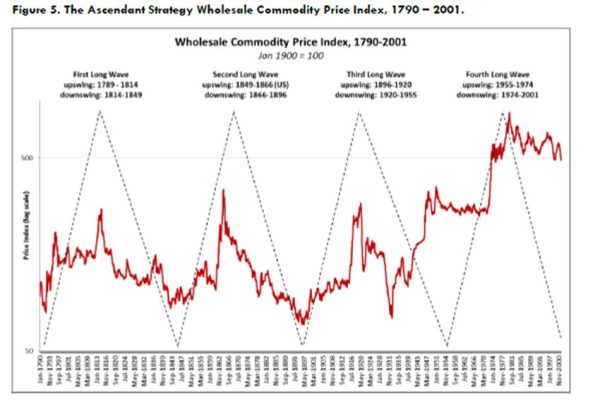



Kondratieff – K Wave
Nikolai Kondratieff, an economist in charge of the Russian Agricultural Bureau (Institute of Conjuncture) in Moscow in the mid 1920’s, who undertook empirical exercises in commodity price data going back to the mid 1700’s for European and the American economies.
Kondratieff found a clearly discernible cycle in the prices of the commodities that he studied, averaging 54 to 60 years in duration; roughly 25 years up, 30 years down…
high prices; 1790 to 1819, 1840’s to 1863, 1896 to 1921
low prices; 1820 to mid 1840’s, mid 1860’s to mid 1890’s, mid 1920’s to 1950.
And extrapolating; high prices, 1950 to 1975, low prices 1976 to late 1990’s, high prices again, late 1990’s to 2025 or so.
In 1924 he was appointed to an agricultural bureau in Moscow.
Josef Stalin asked Kondratieff to forecast when all the enemy (i.e. capitalist) economies would collapse because it was widely considered, certainly by Stalin and others, that Communism was about to take over the world. Stalin needed to be prepared. Nikolai was to work out when that would happen and to give a bit of a heads up to those in power in Russia.
Let us make an important point here: back in the 1920s and before, if you studied economics at University, you simply studied cycles, because it was blindingly obvious to everybody who did economics in those days that the economy WAS cyclical.
And Kondratieff did some astounding work. He went ahead and he studied commodity prices. He looked at pig iron. He looked at wheat. He looked at corn. He looked at all the commodity factors of his day.
What he found was this: commodity prices bottomed in the 1770s. They then peaked in 1819 after the Napoleonic wars. Commodities then bottomed again in the 1840s. They then peaked in the early 1860s with the US Civil War. Then they bottomed again in the late 1890s, then peaked again in the 1920s. As a rough guide, commodity prices rise for 25–30 years and fall for 25–30 years. These became known as ‘K waves’.
Kondratieff discovered that when commodity prices were very low the world was in serious depression. But on the upside of a ‘K wave’ – generally rising commodity prices — enormous wealth is created. It is our belief that we have been on the upside of a K wave since about the year 2000 which is likely to peak in the mid 2020’s. More to come on this and how it could impact the 18.6 real estate cycle.


I have learned a lot from Phil’s presentations, emails and the website. He has always been very generous in sharing the knowledge and insights acquired from his research, explaining the many influences on market movements and the fact that these movements can sometimes be forecast well in advance. Best of all he is very approachable and easy to understand. Keep up the good work Phil!
Connie, Melbourne, December 2011.

I have learned a lot from Phil’s presentations, emails and the website. He has always been very generous in sharing the knowledge and insights acquired from his research, explaining the many influences on market movements and the fact that these movements can sometimes be forecast well in advance. Best of all he is very approachable and easy to understand. Keep up the good work Phil!
Connie, Melbourne, December 2011.



